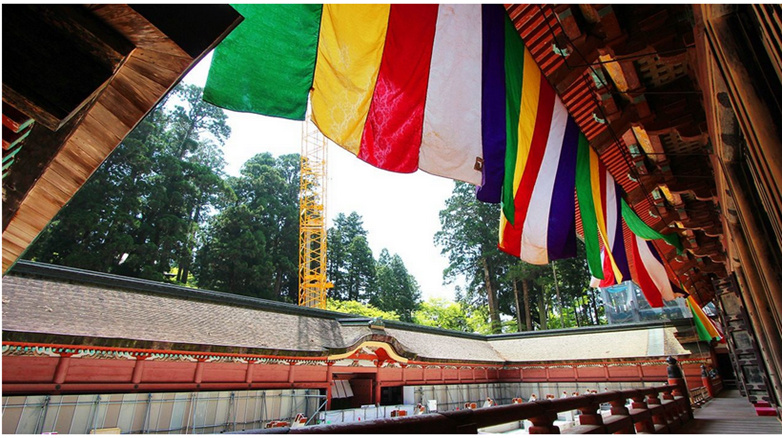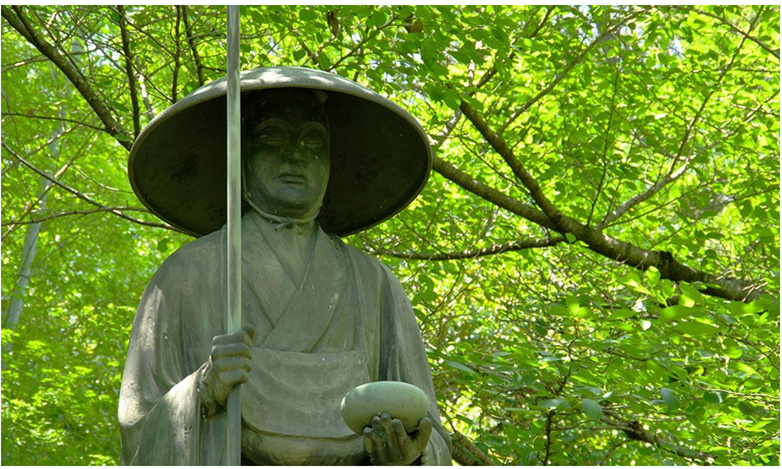The Violent History of Japanese Buddhism

Non-violence is one of the basic principles of Buddhism. But in Japan, where this religion developed without the rules of conduct established by the historical Buddha with the aim of maintaining order among the monastic community, violence became acceptable, and sometimes even encouraged. This led to a deviation from the principles of Buddhism by forming armies of warrior monks, carrying out armed Buddhist rebellions, and enthusiastically supporting the Japanese army’s involvement in World War II.
In Part 5 of this series, I mentioned that one of the things that distinguishes Japanese Buddhism from others is that it never developed a Sangha for monks to live as an independent community in accordance with the Buddha's teachings, and that the code of conduct of the "Vinaya Pitaka" discipline designed to govern and manage the monastic community was not rooted in This country too. This has been the case since the introduction of Buddhism to Japan until the present day. This fundamentally incomplete situation remained uncorrected for 1,300 years.
The lack of an effective Vinaya Pitaka system in Japan has led Japanese Buddhist monks to develop completely different customs and lifestyles from monks in other countries. Things like not performing the Upasampada ritual upon ordination as a priest, drinking alcohol, or getting married and starting a family are all unacceptable actions under the Vinaya Pitaka and warrant punishment. But in Japanese Buddhism, which does not have such a code of conduct, none of these actions are seen as particularly important. If there is any criticism at all, it tends to be limited to simple denunciations. Someone might say, “Of course, it is not advisable to take these practices as a code of conduct,” but that is all that is said.
But of all the distinctive characteristics of Japanese Buddhism, the most dangerous and important is its acceptance of violence. It is not within the Vinaya Pitaka system for monks to resort to violence against others. Not only is it strictly forbidden to fight with weapons, but even when a monk rebukes a student as part of his education or training, he must never use violence to achieve this goal.

Monks are forbidden from even watching military parades. Other religions take the view that although violence for evil ends is a sin, violence for a rightful cause may be permitted under certain circumstances such as in the face of a threat to the religion (the idea of so-called 'holy war'). But this kind of thinking is completely alien to the original teachings of Buddhism, which never permit violence under any circumstances. Violence in all its forms is strongly condemned. It goes against everything Buddha taught. When a person resorts to violence, he turns his back on Buddhist teachings.
Acceptance of violence
The original Buddhism taught by Shakyamuni in India shuns violence. But this basic principle waned over a long period of the religion's history, and a tendency developed to tolerate violence or even support it in some circumstances. Cases can be found in many Buddhist countries where acts of violence have been committed by monks themselves. Even when monks are not directly involved in violence, it is not surprising that they use the influence and influence of the Sangha to aid and abet acts of violence by those in power. This trend can be seen in many Buddhist countries today.
But as long as the Vinaya Pitaka system is in place and continues to be effective, such actions are governed by the disciplinary code of conduct and will be met with disciplinary sanctions as acts inconsistent with the teachings of the religion. In this sense, monks can protect themselves from the instinctive temptation to commit violent acts thanks to the presence of Vinaya Pitaka.
But Japanese Buddhism never established effective rules of conduct. The natural result is for this religion to embrace violence and the concept of holy war.

From an early stage, Buddhism in Japan embraced violence and even celebrated it in appropriate circumstances, with its teachings stating that monks could use violence to protect Buddhist teachings and that fighting to defend the religion was a meritorious act that people should strive to perform effectively.
But the problem is that these “teachings” in this context were not based on the basic truths revealed by Shakyamuni, but rather on the doctrines of the sect to which an individual monk or group of monks belonged. The monks came to believe that the use of violence to protect their position, influence, or private interests could be justified on religious grounds as a legitimate Buddhist act.
Because Japanese Buddhism as a whole developed in an environment that lacked a Vinaya Pitaka code of conduct, the acceptance of violence spread among all sects and schools and infected Japanese Buddhism as a whole.
Perhaps the strengths that make the distinctive characteristics of Japanese Buddhism so unique are the idea that Japanese Buddhism accepts the idea of justified violence, and that the broader secular society that supports the Sangha and Buddhist institutions sees nothing wrong or strange in this situation.

Armies of unruly warrior monks
Nara Buddhism and the Tendai and Shingon schools pursued all vested interests by association with the court, and used violence to defend their position and influence. Perhaps the best example of this is the “Zhuhei (Warrior Monks)”. Many important temples, including the influential Todaiji Temple in Nara and the Tendai sect's headquarters at Enryakuji on Mount Hiei outside Kyoto, employed armies of warrior monks who were often embroiled in unrest and lawlessness, situations that even the emperor could not control.
When new sects of Buddhism developed from the Tendai school in the Kamakura period, they made a name for themselves by declaring their differences from the Tendai school from which those sects arose. These new sects often used violence to protect their positions and defend their new areas of influence. One example is the 'Ikku-ikki' rebellions by groups supported by the Jodo Shinshu sect of Pure Land Buddhism. These revolts struck many areas of the country throughout the fifteenth and sixteenth centuries. Shinran, the founder of the sect, was a humble and peaceful man with no hint of violence in his behavior and teachings. But those who inherited his position as leaders of the sect organized large armies to help them resist the old Buddhist schools that were trying to eliminate the new schools of Pure Land Buddhism. They took the fight to deeply rooted Buddhist sects and their allies in positions of political and cultural power.
The power of these military sects grew to be very large, and over the course of about 100 years from the 15th to the 16th centuries, they were able to exercise almost complete control over large areas of central Honshu. This use of force to expand the influence of a Buddhist sect was not limited to the Jodo Shinshu sect. It was a phenomenon present to a greater or lesser extent in many new sects, and it was accepted that Buddhist monks could often engage in violence.
Japanese Buddhism and World War II
In the Edo period, the political violence that had been widespread on the part of Buddhist sects faded with the end of the years of unrest and long civil war and the unification of the country under the leadership of the Tokugawa shogunate . All Buddhist sects submitted to the authority of the shogunate and coexisted in relative peace and stability under the strict supervision of the central government.

But the basic principle of the Vinaya Pitaka system, which stipulates that Buddhist monks should not engage in violence under any circumstances, was not yet understood. This means that danger still lurks beneath the surface and violence may return once social conditions change.
The rule of the Tokugawa shogunate ended with the start of the Meiji Renaissance in 1868. The shogunate was replaced by a new government that sought to enact radical reforms aimed at modernizing the country and catching up with the Western colonial powers. A new law ordered the separation of Shintoism from Buddhism, creating a violent rift between two traditions that had previously been viewed as complementary parts to form a complementary, syncretic tradition. Shintoism became the country's religion under the new state, while Buddhism declined to a secondary position.
This was the era of the Shinto state centered around the semi-divine figure of the Emperor. Despite the decline in the status of Buddhism, it chose to cooperate with the rising Shinto state. The most important reason for this was that the Buddhist authorities feared the influence of Christianity, which they felt was likely to enter Japan along with other Western influences. Because of its fear of the power and influence of Christianity, Buddhism chose to form a common front with the Shinto state. The Japanese religious world united to confront Christianity, and Japanese Buddhism ended up supporting the authority of the emperor cult in the new nation-state.
Eventually, Japan descended into war with China and the Western powers. Suddenly violence appeared again in Japanese Buddhism, which had been dormant since the Edo period (1603-1868). Japanese Buddhism supported the idea that Japan would fight for a noble cause: for the Emperor to unite Asia and for Japan to lead the world to a new era of prosperity and peace.

This support for the war by Japanese Buddhism, and the extent to which Buddhist monks themselves were involved in the fighting, remained obscure for many years after the war. But recent research has begun to clarify the full extent of Buddhist complicity in the pursuit of Japanese war aims.
Some people strongly criticized the idea that Buddhism should participate in the war, but the high leadership of most sects enthusiastically cooperated, encouraged their followers to get involved, collected alms and donations that went to manufacturing weapons, and delivered sermons that associated the emperor with the supreme figure of Buddha.
The old idea that violence can be tolerated and even encouraged if used to defend a noble cause has reared its head again.
When Japan was eventually defeated, the Emperor publicly renounced his supposed divinity and the sacred world that had grown up around him vanished. Japan's debt structure vanished overnight, and the country remarkably quickly transformed into a democratic nation-state.

Also within this shift, the violence inherent in Japanese Buddhism faded again, and there is no sign of violence in it today (although some people permit certain types of violence in places of ascetic training within Buddhist Buddhism).
But the principle of non-violence has not yet penetrated deeply into Japanese Buddhism. Throughout its long history, Japanese Buddhism has lacked the disciplinary support of the Vinaya Pitaka system. This is one of the problems that must be overcome in the future.
Source : websites

